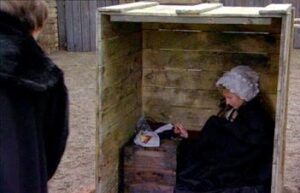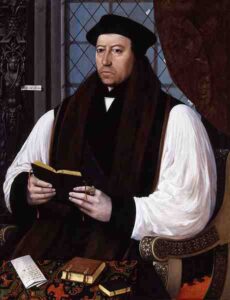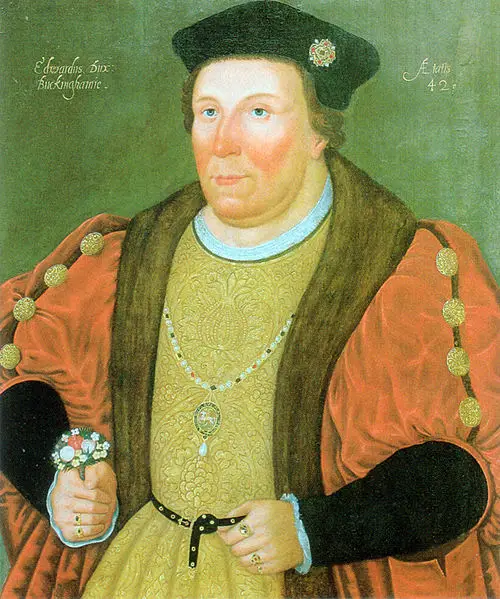 Did Thomas Cranmer, Archbishop of Canterbury, keep his secret wife in a ventilated chest?
Did Thomas Cranmer, Archbishop of Canterbury, keep his secret wife in a ventilated chest?
Well, yes, according to his Catholic detractors!
But was there any truth in their claims, and where does the story come from?
In 1532, Thomas Cranmer, who wasn’t yet Archbishop of Canterbury, was serving King Henry VIII as the resident ambassador at the court of Charles V, Holy Roman Emperor. While he was with the emperor in Nuremberg, Cranmer met the city’s leading Lutheran preacher, Andreas Osiander, and the two became firm friends. Cranmer visited Osiander’s house often and at some point he met Osiander’s wife’s niece, Margarete, and that summer, despite the fact that he was an ordained priest, and was, therefore, supposed to remain celibate, Cranmer married her.
Margarete remained in Nuremberg, while Cranmer continued his mission, travelling with the emperor, but then Cranmer received a letter informing him that the king had appointed him Archbishop of Canterbury and that he was being recalled to England.
There was no way that Margarete could openly accompany Cranmer back to England as his wife, when clerical celibacy was still enforced into England, but at some point, it appears she was able to get into England undetected and managed to live with her husband under the radar until the 1539 Act of Six Articles, which reaffirmed clerical celibacy. It became too risky for her to stay, with the act stating that married priests were felons, and Cranmer, knowing that his enemies were looking out for any way to bring him down, sent her back to Germany.
Margarete’s biographer Mary Prior notes that the king had obviously heard that Cranmer was married, for in 1543, when Cranmer’s enemies were ready to move against him, the king “asked him 'merily' whether 'his inner or privie bed were free from those articles'”. When Cranmer explained himself and showed himself to be loyal to the king, Henry VIII “named his accusers and appointed Cranmer for searching out his own cause”. At which point, according to Prior, Margarete was able to return, although she remained out of sight.
 It wasn’t until 1549, in the Protestant reign of Edward VI, when clerical marriage was legalised, that Margarete appeared in public. By that point, the couple had a daughter, Margaret, and a son, Thomas. But then, in 1553, the Catholic Mary I came to the throne and Cranmer found himself imprisoned for supporting the accession of Lady Jane Grey as Queen Jane. He was found guilty of high treason in November 1553 and then tried for heresy in 1555, and burnt at the stake in March 1556. It is not known where Margarete was during all of this, whether she had fled to Germany or was hiding in England. But she did eventually end up in Germany and married her late husband’s friend, printer and bookseller Edward Whitchurch.
It wasn’t until 1549, in the Protestant reign of Edward VI, when clerical marriage was legalised, that Margarete appeared in public. By that point, the couple had a daughter, Margaret, and a son, Thomas. But then, in 1553, the Catholic Mary I came to the throne and Cranmer found himself imprisoned for supporting the accession of Lady Jane Grey as Queen Jane. He was found guilty of high treason in November 1553 and then tried for heresy in 1555, and burnt at the stake in March 1556. It is not known where Margarete was during all of this, whether she had fled to Germany or was hiding in England. But she did eventually end up in Germany and married her late husband’s friend, printer and bookseller Edward Whitchurch.
That’s a potted history of Cranmer’s marriage to Margarete, but where on earth does this idea come from that he took her on his travels in a box?
Well, it’s because he kept his marriage very secret, and nobody saw Margarete, and because, following his execution in 1556, Cranmer’s Catholic detractors spread the story. Nicholas Harpsfield wrote in his book “A treatise on the pretended divorce between Henry VIII. and Catharine of Aragon” that Cranmer “kept his woman very close, and sometimes carried her about with him in a great chest full of holes” and that in 1543, when there was a fire at his palace in Canterbury, Cranmer was frantic about the fate of a box. Harpsfield wrote, “lord what a stir and care was there for this pretty nobsey and for this chest; all other care in a manner was set aside. He caused that chest with all speed to be conveyed out of danger, and gave great charge of it, crying out that his evidences and other writings which he esteemed above any worldly treasure were in that chest”. Harpsfield was making out that Margarete was in the box. Catholic recusant Nicholas Sander, who wrote “Rise and Growth of Anglican Schism” in Elizabeth I’s reign, repeated the story in his book. And both Harpsfield and Sander wrote of Cranmer’s brother, Edmund, Archdeacon of Canterbury, keeping a wife secretly too, although not in a box.
There is absolutely no evidence that Margarete ever hid in a box. It was a smear campaign by Cranmer’s enemies to blacken his reputation and legacy. In his 19th century book on Cranmer, Robert Edmond Chester Waters wrote of how the story was contradicted in Elizabeth I’s reign by Sir John Harington on the authority of Margarete’s daughter-in-law, who was still alive and who was related to Harington’s wife.
But it’s still a colourful tale, and no wonder Showtime’s “The Tudors” series brought it to life on TV!



Leave a Reply